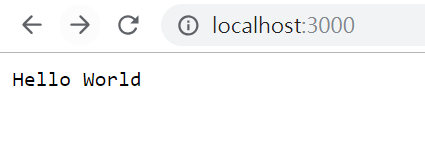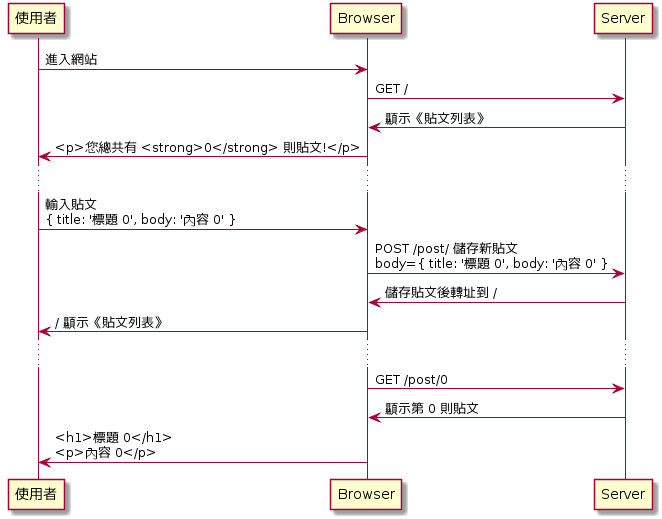第 10 章 – 驗證 (整合測試)
在本書第 2 章,我們透過模仿 lodash 專案,經由實作學習了《單元測試/TDD/BDD》等基礎的測試概念,但是當我們所撰寫的是《應用程式》,而不是基礎函式庫時,就必須進行《系統測試》,這類測試必須引入更高階的函式庫。
舉例而言,假如我們想測試 server 端的程式,我們可以使用 supertest 這個套件,supertest 可以對 http 協定的伺服器進行測試,對於傳統類以 server 為主的網站,supertest 就很夠用了。
第一部分: Server 端的測試
在本章的第一部分中,我們將介紹如何用 mocha + supertest 進行傳統型 Server 網站測試!
supertest
Supertest 是個 http server 的測試框架,只能測後端 server ,但是無法測試前端瀏覽器。
以下是一個來自 koa 官方範例 koa-example 的 supertest 案例:
假如我們用 koa 寫一個名稱為 server.js 的簡單 hello 伺服器
const Koa = require('koa')
const server = (module.exports = new Koa())
server.use(async function (ctx) {
console.log('url=', ctx.url)
ctx.body = 'Hello World'
})
if (!module.parent) server.listen(3000)
我們打開瀏覽器會看到下列狀況!

然後我們可以用 supertest 寫個測試程式 test.js 如下:
const server = require('./server').listen()
const request = require('supertest').agent(server)
describe('Hello World', function () {
after(function () {
server.close()
})
it('should say "Hello World"', function (done) {
request.get('/').expect(200).expect('Hello World', done)
})
})
接著可以用 mocha 測試該程式,執行結果如下:
PS D:\course\sejs\example\06-system\01-classic\01-hello> mocha
Hello World
url= /
√ should say "Hello World" (85ms)
1 passing (112ms)
這樣,您應該會用 supertest 了!
但是、上述範例太陽春了,我們需要更完整的系統來展示 Server 端系統測試,因此我們將 koa 官方的 Blog 範例 修改之後,成為《BlogMVC 簡易網誌系統》並進行測試,您可以在下列網址看到 BlogMVC 專案完整的程式碼:
BlogMVC 測試規劃
BlogMVC 這樣的《簡易網誌系統》,若寫成 RESTful 形式的表達方式,可以描述如下:
- GET / :
- 傳回《貼文列表》\n目前只有 0 則貼文
- POST /post/ : body={ title: ‘貼文 0’, body: ‘內容 0’ }
- 應該會創建新貼文 (post 0),然後轉址到根目錄 / 後顯示《貼文列表》
- GET /post/0 :
- 應該會看到第 0 則貼文
若使用 UML 當中的《循序圖》(Sequence Diagram) 描述該案例,則可繪製出下列循序圖:
@startuml
使用者 -> Browser : 進入網站
Browser -> Server : GET /
Server -> Browser : 顯示《貼文列表》
Browser -> 使用者 : <p>您總共有 <strong>0</strong> 則貼文!</p>
...
使用者 -> Browser : 輸入貼文\n{ title: '標題 0', body: '內容 0' }
Browser -> Server : POST /post/ 儲存新貼文\nbody={ title: '標題 0', body: '內容 0' }
Server -> Browser : 儲存貼文後轉址到 /
Browser -> 使用者 : / 顯示《貼文列表》
...
Browser -> Server : GET /post/0
Browser <- Server : 顯示第 0 則貼文
使用者 <- Browser : <h1>標題 0</h1>\n<p>內容 0</p>
@enduml

BlogMVC 測試程式
透過這樣的分析,要寫出測試案例就容易了。
/* eslint-env mocha */
const expect = require('chai').expect
const server = require('./server').listen()
const request = require('supertest').agent(server)
describe('簡易網誌系統', function () {
after(function () {
server.close()
})
describe('GET /', function () { // 路徑 GET /
it('內文標題應該為《貼文列表》,而且只有 0 則貼文', function (done) {
request.get('/').expect(200, function (err, res) {
if (err) return done(err)
expect(res.header['content-type']).to.include('html') // 根目錄是個 html 文件
expect(res.text).to.include('<title>貼文列表</title>') // 內文標題為 Posts
expect(res.text).to.include('<p>您總共有 <strong>0</strong> 則貼文!</p>')
done()
})
})
})
describe('POST /post', function () { // 路徑 POST /post/new
it('應該會創建新貼文,然後轉址到根目錄 /', function (done) {
request
.post('/post')
.send({ title: '貼文 0', body: '內容 0' })
.end(function (err, res) {
if (err) return done(err)
expect(res.header.location).to.equal('/') // 路徑 / => 根目錄是個 html 文件
done()
})
})
})
describe('GET /post/0', function () {
it('應該會看到第 0 則貼文', function (done) {
request.get('/post/0').expect(200, function (err, res) {
if (err) return done(err)
expect(res.header['content-type']).to.include('html')
expect(res.text).to.include('<h1>貼文 0</h1>')
expect(res.text).to.include('<p>內容 0</p>')
done()
})
})
})
})
BlogMVC 測試結果
PS D:\course\sejs\project\blogMvc> mocha
簡易網誌系統
GET /
<-- GET /
--> GET / 200 30ms 1.13kb
√ 內文標題應該為《貼文列表》,而且只有 0 則貼文 (116ms)
POST /post
<-- POST /post
--> POST /post 302 81ms 33b
√ 應該會創建新貼文,然後轉址到根目錄 / (97ms)
GET /post/0
<-- GET /post/0
--> GET /post/0 200 3ms 1.02kb
√ 應該會看到第 0 則貼文
3 passing (288ms)
第二部分:包含 AJAX 的網站之測試
對於新一代強調瀏覽器功能,具有《使用者介面互動與前端 JavaScript》的 AJAX (web 2.0) 程式而言,supertest 就無能為力了,此時我們可以引入像 Puppetter、 Selenium,TestCafe 等這類的《隱形瀏覽器》(Headless Browser),透過程式去操控《隱形瀏覽器》來測試網站,而不是每次都用手工去測試,這樣會耗費大量的人力,吃力又不討好!
- Puppetter – https://github.com/GoogleChrome/puppeteer
- TestCafe – https://github.com/DevExpress/testcafe
- Selenium – https://www.seleniumhq.org/
測試程式
/* eslint-env mocha */
const ok = require('assert').ok
const app = require('./server').listen(3000)
const puppeteer = require('puppeteer')
var browser, page
const opts = {
// headless: false,
slowMo: 100,
timeout: 10000
}
describe('blogAjax', function () {
before(async function () {
browser = await puppeteer.launch(opts)
page = await browser.newPage()
})
after(function () {
browser.close()
app.close()
})
describe('puppeteer', function () {
it('GET / should see <p>You have <strong>0</strong> posts!</p>', async function () {
await page.goto('http://localhost:3000', {
waitUntil: 'domcontentloaded'
})
let html = await page.content()
ok(html.indexOf('<p>You have <strong>0</strong> posts!</p>') >= 0)
})
it('click createPost link', async function () {
await page.click('#createPost')
let html = await page.content()
ok(html.indexOf('<h1>New Post</h1>') >= 0)
})
it('fill {title:"aaa", body:"aaa"}', async function () {
await page.focus('#title')
await page.keyboard.type('aaa')
await page.focus('#body')
await page.keyboard.type('aaa')
await page.click('#savePost')
})
it('should see <p>You have <strong>1</strong> posts!</p>', async function () {
let html = await page.content()
ok(html.indexOf('<p>You have <strong>1</strong> posts!</p>') >= 0)
})
it('should see <p>You have <strong>1</strong> posts!</p>', async function () {
await page.click('#show0')
let html = await page.content()
ok(html.indexOf('<h1>aaa</h1>') >= 0)
})
})
})
測試過程
PS D:\course\sejs\project\blogAjax> mocha --timeout 100000
blogAjax
puppeteer
<-- GET /
--> GET / 200 128ms 1.04kb
<-- GET /main.js
--> GET /main.js 200 12ms 1.96kb
<-- GET /list/
--> GET /list/ 200 15ms 2b
√ GET / should see <p>You have <strong>0</strong> posts!</p> (1322ms)
√ click createPost link (839ms)
<-- POST /post
create:id=> 0
create:get=> { title: 'aaa', body: 'aaa' }
create:save=> { title: 'aaa',
body: 'aaa',
created_at: 2018-10-22T09:00:08.151Z,
id: 0 }
--> POST /post 404 87ms -
<-- GET /list/
--> GET /list/ 200 17ms 77b
√ fill {title:"aaa", body:"aaa"} (2713ms)
√ should see <p>You have <strong>1</strong> posts!</p> (106ms)
<-- GET /post/0
--> GET /post/0 200 5ms 75b
√ should see <p>You have <strong>1</strong> posts!</p> (666ms)
5 passing (15s)
結語
在本章的第一部分,我們示範了如何用 supertest 測試經典網站。然後在第二部分示範了如何用 puppeteer 測試有前端 JavaScript + AJAX 的網站。
對於傳統的視窗程式,像是 Windows 的 C# 視窗程式,也有一些專用的測試方法與工具,您可以參考以下文章:
進階參考: 使用 UI 自動化來測試您的程式碼
同樣的,對於手機上的 APP,也有很多進行《系統測試》的工具,可以模仿用戶行為對 APP 進行測試,請參考下列文章:
進階參考: 几款Android 应用自动化测试工具
練習
練習 1 – Supertest 測試初體驗
- 請找出 koa 的官網並閱讀之
- 請找出 koa 的官方範例並閱讀 README.md
- 請閱讀 hello-world 範例並執行之
- 請用 mocha + supertest 測試 hello 範例
- mocha test.js
練習 2 – 經典網誌 Blog 的 supertest 測試
- 請閱讀 blog 範例並執行之
- 請用 mocha + supertest 測試 blog 範例
- mocha test.js
- 請閱讀修改過的 blogMVC 範例並執行之
- 請用 mocha + supertest 測試 blogMVC 範例
- mocha test.js
練習 3 – 使用 puppeteer 測試 BlogAjax 網誌系統
- 請執行 blogAjax 範例
- 請閱讀 blogAjax 的原始碼
- 請用 mocha + puppeteer 測試 blogAjax 範例
- mocha test.js